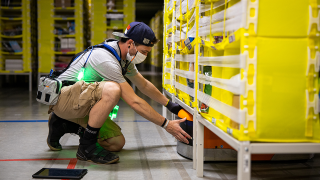Amazon Value Chain: How its Reimagining Its Fulfillment Network

Amazon shed more light on how the company is reconfiguring its fulfillment network to significantly shrink delivery windows via regionalization.
The company has transitioned its stores’ fulfillment and transportation network from one national network in the United States to eight separate regions serving smaller geographic areas. It’s also expanded the number of smaller, same-day delivery facilities, which it plans to double.
By keeping a wide selection of inventory in each region, Amazon is delivering items to consumers faster and more affordably, said CEO Andy Jassy in an earning call this week, who noted: “Regionalization is working.”
The company has reduced the number of touches for a delivered package by 20% and shortened the miles traveled to deliver packages to customers by 19%. They’ve also increased the number of deliveries fulfilled within a region to 76%.
Jassy said their data indicates customers purchase “meaningfully” more often when there are faster delivery promises on a product detail page, and it also changes consideration of using Amazon for future purchases. What’s more, fulfilling shipments closer to customers decreases transportation costs and is more eco-friendly, he added.
Why Amazon Is Adding Same-Day Fulfillment Centers
Getting shipments closer to Amazon customers has required significant work and invention surrounding regionalization, according to Jassy, as well as placement logic and local in-stock algorithms.
The expansion of its same-day fulfillment facilities has played a key role, which the exec cited as being Amazon’s fastest and among the least-expensive fulfillment mechanisms.
These facilitates are located in the largest U.S. metro areas, and they fulfill both the company’s top-moving 100,000 SKUs and several million other SKUs from nearby centers.They’re smaller and contain less conveyance, according to Jassy, who said they’re designed to get items from order placement to delivery-ready in as little as 11 minutes.
“While we're seeing strong early results from this regionalization effort, we still see several ways in which we can be more efficient in this structure and we believe will improve productivity further,” he noted. “We've also reevaluated virtually every part of our fulfillment network this past year and see additional structural changes we can make that provide future upside.”
This article also appeared on CGT, a sister publication of RIS.




